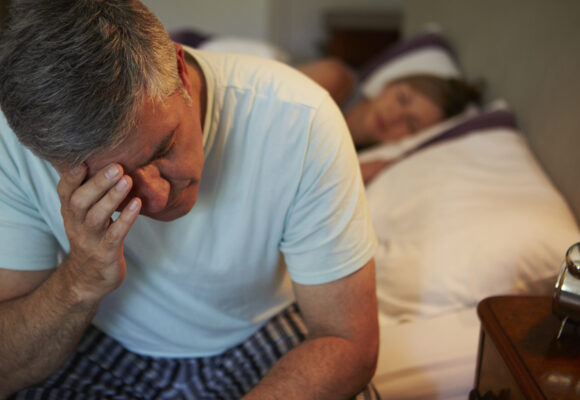Sleeping with COPD symptoms can be difficult, to say the least. FLASS knows coughing startles you. The wheezing pulls you right out of your dream state. And, if that’s not enough, your prednisone or your inhaler has jazzed up your system to the point where you cannot keep your mind on resting. Read more to discover our five tips for sleeping with this disease–or rather despite it.

Is your COPD keeping you awake? FLASS offers you some great answers.
Sleeping With the Enemy: Chronic Obstructive Pulmonary Disease
There is an old movie with the title, “Sleeping with the Enemy.” And, although the movie has nothing to do with disease, the title reminds us of the challenges facing our COPD patients.Medical writer, Beth W. Orenstein, recently stated the importance of sleep for patients with COPD.
She said, in the popular online magazine, Everyday Health, “Sleep is important for everyone.” And then she added, “But if you have chronic obstructive pulmonary disease, getting a good night’s rest is essential to be able to breathe well and function the next day.” What Is COPD (Chronic Obstructive Pulmonary Disease)? Symptoms, Causes, and More | Everyday Health Thus, FLASS selected as our blog topic this week, tips for sleeping despite COPD.

Do You Dream of Better Sleep? Raise you head to open your airway.
We also recommend these tips to anyone suffering from any chronic respiratory disease. We think that this problem is worthy of our time because studies show that 75 percent of COPD patients report nighttime symptoms and grave difficulty getting and staying, asleep.
The FLASS 5 Strategies for Sleeping With COPD
Let’s get right to the point with some proactive tips to help you get both the quality and quantity of sleep you need despite your COPD.
FLASS Strategy 1 of 5 for Sleeping With COPD: Limit Your Naptime
- Now, you might have a deep craving for your naptime. In fact, you might physically, medically, and mentally need it. We are not telling you to completely quit your napping. We are telling you that you should keep it short. 30 minutes is the limit we recommend.
- Likewise, we recommend napping early in the afternoon. Thus, it won’t interfere with your nighttime slumber. If you absolutely need a nap, keep it short — no longer than 30 minutes — and avoid napping in the late afternoon.
- FLASS agrees that a short nap restores energy. The keyword here is “short.” However, a long nap, especially late afternoon, can worsen your cycle of sleep. Then it can keep you awake during your family’s sleep time. Additionally, those, long afternoon naps can give you a crushing and habitual problem of excessive daytime sleepiness.
2. Adjusting Your Position for Sleeping With COPD: FLASS Sleep Strategy Number Two
We have it on good authority from the American Lung Association that changing your sleeping position will lead you to more restful sleep despite COPD.
- Elevate your head. Not only does this open your airway, but it also prevents acid reflux. That is the disgusting phenomenon of having stomach acid back up from your esophagus into your mouth. It is certain to awaken you at night.
Did you know this condition, named gastroesophageal reflux disease (or GERD)? It happens quite commonly in COPD patients? A simple help for it is learning to sleep in a position that takes the pressure off the esophagus.
- We also know it can be quite a difficult adjustment for our COPD patients to make. If you sleep tightly curled up, being upraised, on your back with a pillow under your knees can be a major challenge. But please try it. If you must side-sleep, still raise the head, but also hug a body pillow. Support your esophagus, breathing mechanisms, chest, and gut. And you can ease your knees by putting a small pillow between them.
3. Unplugging the COPD Patient from Electronics: Our Third Sleep FLASS Strategy for Sleeping With COPD
Here is a sleep strategy we even recommend to our healthy patients. Before bedtime, create 30-60 minutes without devices. (Oops! We heard you scream a little.)
Many patients use television, cell phones, and tablets during this time. However, electronic devices cause an excess of mental stimulation this close to bedtime. It is self-defeating if you want a good night’s sleep.
Likewise, experts inform us that the blue light of the screen squelches our body’s production of an important sleep-inducing hormone, melatonin. And, okay, if you just must see a screen within an hour of bedtime, set it to “night mode.” At least that will mitigate the power of the blue light.

Just a Few Extra Steps of exercise Make a big Difference if your COPD keeps you awake at Night.
4. The FLASS Number Four Strategy for Sleeping with COPD: Activate Your Day
No one likes to hear they need more exercise. Yet it is critical to your living with COPD. “Exercise is something that improves COPD in general,” states Dr. Schachter, COPD expert states. Even a gentle, moderate exercise routine has several benefits:
- Exercise improves how your body uses oxygen.
- Physical activity, even walking hallways a few times a day, will reduce your shortness of breath.
- With COPD you might fear fatigue, but some exercise will give you more energy.
- Activity decreases your anxiety and helps you fight depression.
Finally, daily exercise is a great aid for sleeping with COPD. American Lung Association (ALA).

Check With Your Doctor to See if Your COPD medication is preventing good rest.
5. FLASS Sleep Strategy Number Five for Sleeping with COPD: Talking to Your Doctor About Your Medication
- Are you aware that some of your medications might be interfering with your sleep? Some COPD medications make sleeping with COPD very difficult. See a list of some of the anti-sleep culprits below.
- These medications improve your symptoms but also might deprive you of sleep or reduce the quality of your sleep. Examples are theophylline, theophylline 4, Theo-24, Theocon, and Elixophyllin.
- As mentioned above, prednisone can also add difficulty to sleeping with COPD. Perhaps you can minimize the effects of these drugs by carefully adjusting your scheduled time to take them. Getting a better night’s sleep can be that simple.
Terrific Takeaways for Sleeping with COPD
For more information about your COPD, FLASS highly recommends this outstanding online resource. We thank you for reading our blog. Additionally, we invite you to read Part II of this topic, Sleeping with COPD next week when we give you a few more tips and tricks to our pulmonary version of Sleeping with the Enemy.

